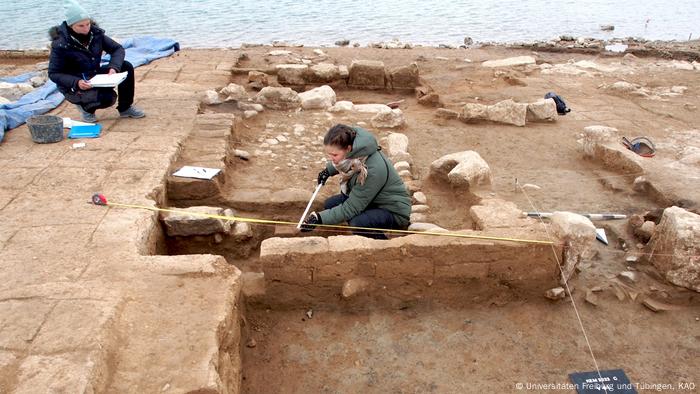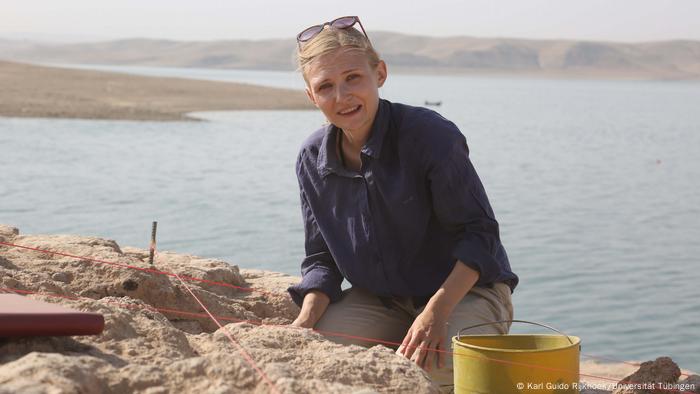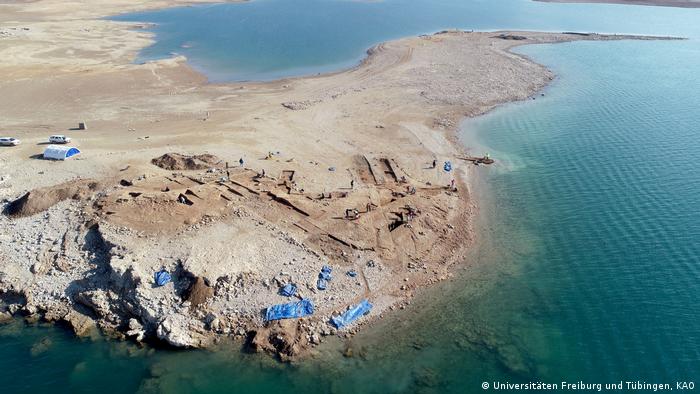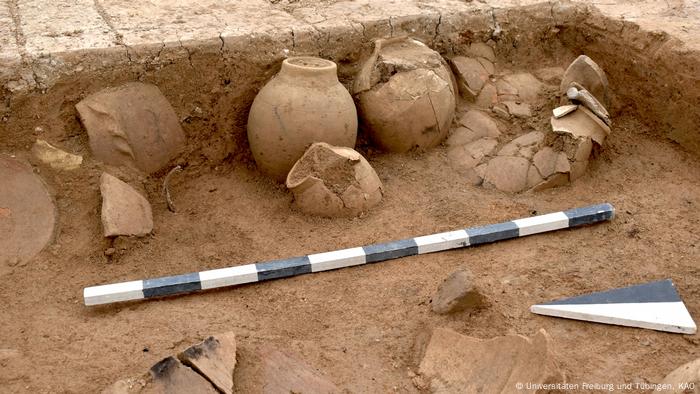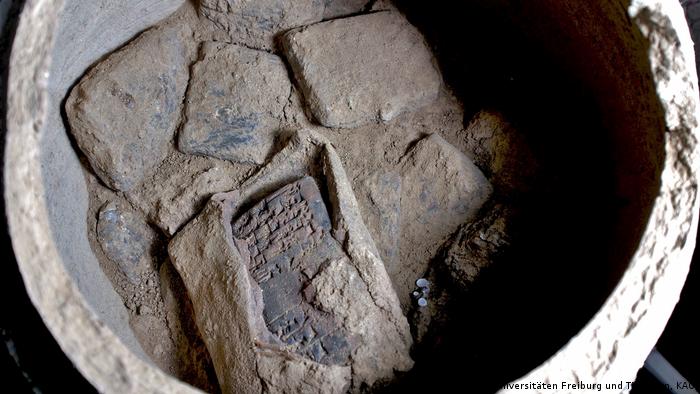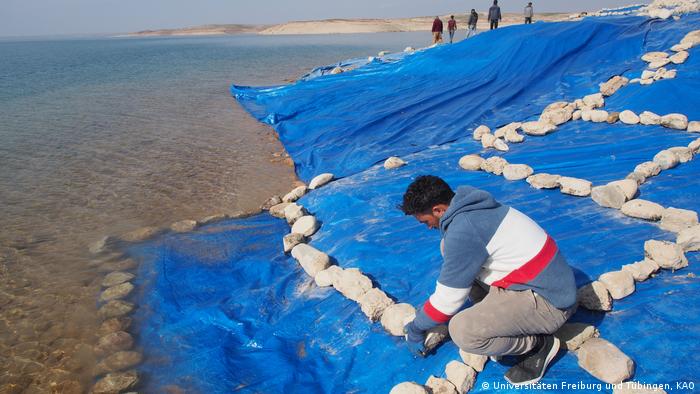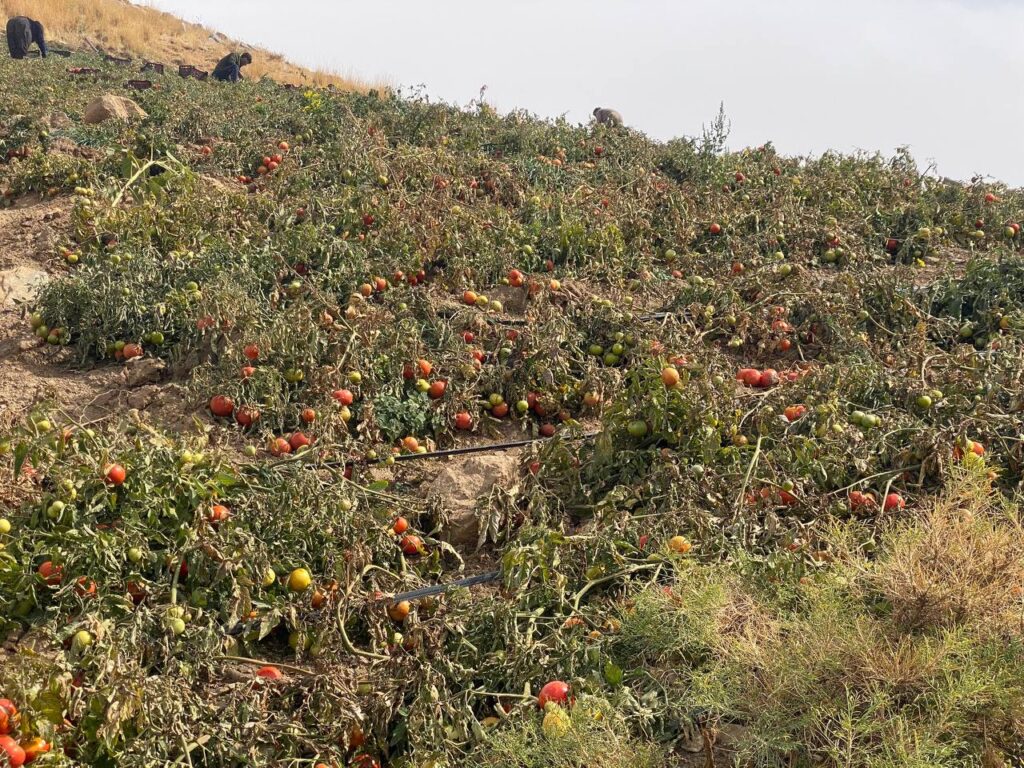Archeology sensation: An ancient city reemerges in Iraq reservoir

Southern Iraq has been suffering from extreme drought for months. Since December, large amounts of water have been diverted from the Mosul Dam, Iraq's most important water reservoir, to prevent harvests from drying out.
Due to the low water level, the remains of a 3,400-year-old city that disappeared decades ago emerged on the edge of the reservoir.
"I saw on satellite images that the water level was falling but it wasn't clear when the water would rise again. So, we had an unknown window of time," says German archaeologist Ivana Puljiz, a junior professor at the University of Freiburg.
But archaeologists knew that the site — known as Kemune — was interesting. They had been there before.
Archeologists had little time to uncover and document the remains of large ancient buildings at the site known as Kemune
So, Puljiz got together with Hasan Ahmed Qasim, a Kurdish archaeologist and director of the Kurdistan Archeology Organization, and Peter Pfälzner, a German archeology professor at the University of Tübingen, to carry out a spontaneous rescue excavation.
They quickly put together a team of German and Kurdish archaeologists to uncover and document as much of the large site as they could.
The team surveyed the Bronze Age city for seven weeks in January and February 2022 before it was completely flooded again.
Emergency excavation reveals large buildings
During a similar dry phase in 2018, the researchers had discovered a fortress-like palace located nearby on a small hill. It was bordered by a large terrace wall.
Archaeologist Puljiz working on ancient ruins uncovered when a reservoir in Iraq dried up during a drought
At the time, Ivana Puljiz's team found the remains of wall paintings in bright red and blue tones, thought to be a typical feature of such palaces.
The fact that the pigments were preserved despite the flooding was "an archaeological sensation," Puljiz told DW after their 2022 visit to the site.
"Of course we had high hopes. Based on the things we had found in 2018, we knew that this site could bring interesting findings. But we didn't know what exactly we would find [this time]," said Puljiz.
The team was not disappointed: During this year's excavation, the archeologist said they were able to uncover other large buildings, such as a massive fortification with a wall and towers that surrounded the city.
Mighty city dominated the surrounding area
The researchers' discovery of a large, multi-story warehouse full of supplies was particularly exciting.
The extent of what was once possibly a mighty city can only truly be viewed from above
"The sheer size of this building alone shows that it had to have housed an enormous amount of goods. And these goods had to be produced and brought there first," said Puljiz. It suggests the city obtained its supplies from a surrounding area it controlled.
Puljiz said their initial findings suggested the extensive city complex could be ancient Zachiku, an important center in the Mitanni empire (circa 1550 to 1350 BC). Zachiku controlled large parts of northern Mesopotamia and Syria.
However, not much is known about ancient Zachiku. "There are very, very few mentions of this city name in other sources, so we are only now bringing new knowledge to light about it," Puljiz said.
Ceramic vessels with over 100 cuneiform inscriptions
The walls and foundations of the building appear to be in surprisingly good condition, said Puljiz, despite their being made of unfired adobe bricks that have been under water for decades.
The researchers discovered clay vessels containing numerous cuneiform tablets that may reveal information about an ancient city
It's possible that a massive earthquake that struck the city around 1350 BC helped preserve those walls — when the building was destroyed and the rubble fell, it may have covered the lower parts of the wall, thereby preserving them.
One of the most fascinating finds, said the researcher, was the discovery of five ceramic vessels, containing over 100 cuneiform tablets, as if in a kind of archive.
Cuneiform is one of the oldest forms of writing. Some of the clay tablets were even found in clay "envelopes."
"When you think that these clay tablets — which aren't fired, they're just solid clay — were underwater for so long and survived and hopefully can soon be read by a philologist, then that's really a sensation," said Puljiz.
Unknown empire of the Mitanni
Those clay tablets were created in the Middle Assyrian period, shortly after that devastating earthquake, when people may have started to settle on the ruins of the ancient city again.
The archeologists says it's a "sensation" that unfired clay tablets found at the site in modern-day Iraq weren't destroyed even after many years underwater
The cuneiform texts may now provide information about the end of the Mitanni-period and the beginning of Assyrian rule in the region. The kingdom of Mitanni is still considered one of the least explored states of antiquity.
During its heyday in the middle of the second millennium BC, the kingdom stretched from the Mediterranean coast across modern-day Syria to northern, modern-day Iraq.
Heartland of the Mitanni lies in darkness
Mitanni royalty are said to have maintained a lively exchange with Egyptian pharaohs and Babylonian rulers. Around 1350 BC, however, the Mitanni empire was conquered by neighboring Hittites and Assyrians.
Archeologists hope plastic sheeting and a gravel fill will protect the remains of an ancient city in Iraq until the next time it is revealed from under the Iraqi reservoir
The events that led to the city's fall remain unclear. To learn more about the Mitanni empire, researchers would need to investigate the center of the former empire — which was probably located in what is now northern Syria — said archaeologist Puljiz.
But the many years of war in the region have made such archaeological digs impossible.
"Without finding notable texts from the center of the empire, it is very difficult to get a picture of how it functioned, what held it together or what landowners did. So far we only have single, spotlight sources from peripheral areas, like now from what is probably ancient Zachiku," said Puljiz. "But the core area remains in the dark."
Before the ruined city was submerged again by the reservoir, the archeologists covered the excavated buildings with a tight-fitting plastic film and gravel to protect them from further damage. With luck, the lost city of the Mitanni will reappear another time.
